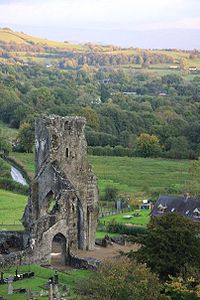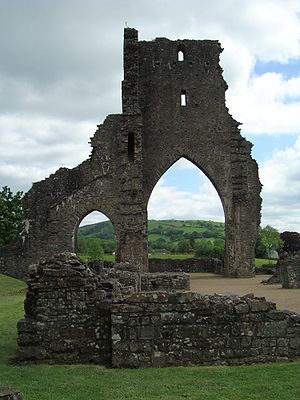
Talley Abbey
Encyclopedia


Monastery
Monastery denotes the building, or complex of buildings, that houses a room reserved for prayer as well as the domestic quarters and workplace of monastics, whether monks or nuns, and whether living in community or alone .Monasteries may vary greatly in size – a small dwelling accommodating only...
of the Premonstratensian
Premonstratensian
The Order of Canons Regular of Prémontré, also known as the Premonstratensians, the Norbertines, or in Britain and Ireland as the White Canons , are a Catholic religious order of canons regular founded at Prémontré near Laon in 1120 by Saint Norbert, who later became Archbishop of Magdeburg...
s ("White Canons") in the village of Talley
Talley
Talley is a small village located in Carmarthenshire, Wales. It is known for the ruins of Talley Abbey a former Premonstratensian abbey destroyed in about 1536 during the Dissolution of the Monasteries.- External links :...
in Carmarthenshire
Carmarthenshire
Carmarthenshire is a unitary authority in the south west of Wales and one of thirteen historic counties. It is the 3rd largest in Wales. Its three largest towns are Llanelli, Carmarthen and Ammanford...
, Wales
Wales
Wales is a country that is part of the United Kingdom and the island of Great Britain, bordered by England to its east and the Atlantic Ocean and Irish Sea to its west. It has a population of three million, and a total area of 20,779 km²...
, six miles (10 km) north of the market town of Llandeilo
Llandeilo
Llandeilo is a town in Carmarthenshire, Wales, situated at the crossing of the River Towy by the A483 on a 19th century stone bridge. Its population is 1,731.The town is served by Llandeilo railway station on the Heart of Wales Line.- Early history :...
. It lies in the River Cothi
River Cothi
The River Cothi is the largest tributary of the River Tywi in south Wales. It is noted for its trout and sea trout fishing and for its beautiful scenery.-Dolaucothi:...
valley. Access to the site of the abbey
Abbey
An abbey is a Catholic monastery or convent, under the authority of an Abbot or an Abbess, who serves as the spiritual father or mother of the community.The term can also refer to an establishment which has long ceased to function as an abbey,...
is free.
The Order was founded in 1120. In 1126, when it received papal approbation by Pope Honorius II
Pope Honorius II
Pope Honorius II , born Lamberto Scannabecchi, was pope from December 21, 1124, to February 13, 1130. Although from a humble background, his obvious intellect and outstanding abilities saw him promoted through the ecclesiastical hierarchy...
, there were nine houses; others were established in quick succession throughout western Europe, so that at the middle of the fourteenth century there were some 1,300 monasteries for men and 400 for women. They came to England about 1143, first at Newhouse in Lincoln, and before the dissolution under Henry VIII there were 35 houses. Soon after their arrival in England, they founded Dryburgh Abbey
Dryburgh Abbey
Dryburgh Abbey, near Dryburgh on the banks of the River Tweed in the Scottish Borders, was nominally founded on 10 November 1150 in an agreement between Hugh de Morville, Lord of Lauderdale and Constable of Scotland, and the Premonstratensian canons regular from Alnwick Abbey in Northumberland...
in the Borders area of Scotland
Scotland
Scotland is a country that is part of the United Kingdom. Occupying the northern third of the island of Great Britain, it shares a border with England to the south and is bounded by the North Sea to the east, the Atlantic Ocean to the north and west, and the North Channel and Irish Sea to the...
, which was followed by other communities at Whithorn Priory
Whithorn Priory
Whithorn Priory is located in Wigtownshire, Galloway. It was founded about the middle of the twelfth century, in the reign of David I, by Fergus, Lord of Galloway, with Gille Aldan, Bishop of Galloway, for Premonstratensian Canons, referred colloquially in Britain as the White Canons.The canons of...
, Dercongal Abbey
Dercongal Abbey
Dercongal Abbey was a Premonstratensian monastic community located in Dumfriesshire, Scotland. The date of its foundation is not known, but it was certainly in existence as a Premonstratensian monastic community by 1225. The founder was presumably Alan, Lord of Galloway...
and Tongland Abbey
Tongland Abbey
Tungland or Tongland Abbey was a Premonstratensian monastic community located in Galloway. It was probably founded in 1218 by Alan, Lord of Galloway, although the church of Tongland had previously been granted to Dercongal Abbey by his grandfather Uchtred in the early 1160s. Few of its early abbots...
all in the Borders area, as well as Fearn Abbey
Fearn Abbey
Fearn Abbey - known as "The Lamp of the North" - has its origins in one of Scotland's oldest pre-Reformation church buildings. Part of the Church of Scotland and located to the southeast of Tain, Ross-shire, it continues as an active parish church .The original Fearn Abbey was established in either...
in northern Britain.
Description
The monastery, which was founded by Rhys ap GruffyddRhys ap Gruffydd
Rhys ap Gruffydd or ap Gruffudd was the ruler of the kingdom of Deheubarth in south Wales. He is commonly known as The Lord Rhys, in Welsh Yr Arglwydd Rhys, but this title may not have been used in his lifetime...
in or about 1185, is in the care of Cadw
Cadw
-Conservation and Protection:Many of Wales's great castles and other monuments, such as bishop's palaces, historic houses, and ruined abbeys, are now in Cadw's care. Cadw does not own them but is responsible for their upkeep and for making them accessible to the public...
. In common with Strata Florida Abbey
Strata Florida Abbey
Strata Florida Abbey Flowers. Ystrad corrupts into Strata, while Fflur is the name of the nearby river. After the region around St. David's was firmly occupied by the Norman Marcher lordship of Pembroke by the early 12th century, with St...
, it was once claimed to be the site of the grave of the medieval Welsh poet
Medieval Welsh literature
Medieval Welsh literature is the literature written in the Welsh language during the Middle Ages. This includes material from the fifth century, when Welsh was in the process of becoming distinct from the British language, to the works of the 16th century....
Dafydd ap Gwilym
Dafydd ap Gwilym
Dafydd ap Gwilym , is regarded as one of the leading Welsh poets and amongst the great poets of Europe in the Middle Ages. Dafydd ap Gwilym (c. 1315/1320 – c. 1350/1370), is regarded as one of the leading Welsh poets and amongst the great poets of Europe in the Middle Ages. Dafydd ap Gwilym...
, but this is one of the discredited theories of Iolo Morganwg
Iolo Morganwg
Edward Williams, better known by his bardic name Iolo Morganwg , was an influential Welsh antiquarian, poet, collector, and literary forger. He was widely considered a leading collector and expert on medieval Welsh literature in his day, but after his death it was revealed that he had forged a...
. There are two lakes near the abbey ruins, which was used for fish farming
Fish farming
Fish farming is the principal form of aquaculture, while other methods may fall under mariculture. Fish farming involves raising fish commercially in tanks or enclosures, usually for food. A facility that releases young fish into the wild for recreational fishing or to supplement a species'...
to support the community of monks. The abbey was dissolved by Henry VIII and the structure mined by the villagers for stone to build much of the present village and the chapel next to the abbey. The ruinous tower is surrounded by steep wooded hills, and it can be reached by a circuitous lane from the main road. It is well signposted.
As with many village communities, it was well populated in the Victorian period, as described by Lewis:
TALLEY, otherwise TÀL-Y-LLYCHAU, a parish, in the union of LLANDILO-VAWR, lower division of the hundred of CAYO, county of CARMARTHEN, SOUTH WALES, 7 miles (N.) from Llandilo-Vawr: containing 1068 inhabitants, of whom 418 are in the Lower, and 650 in the Upper, division. This place, of which the name, signifying "the head of the lakes," is derived from two large pools, near the church, of about fifty acres in extent, was originally of much greater importance than at present, and the seat of one of the most extensive and venerable ecclesiastical establishments in this part of the principality. The parish . . . comprises by admeasurement 7167 a. 2 r. 19 p., of which the arable proportion may consist of about two-thirds in relation to the pasture, and nearly 200 acres are woodland, and 290 a. 8 p. a common. The surface displays a continued succession of hill and dale, sideland and mountain top, and is rather woody . . . The seat, Edwinsford, stands in the north-west on the confines of the parish, of about half of which the owner of the house is the landed proprietor . . . The church, dedicated to St. Michael, having fallen into decay, was rebuilt in the Grecian style, in 1773 . . . principally from the ruins of the ancient abbey . . . There are places of worship for Baptists and Calvinistic Methodists . . . In the parish are two day schools . . . There are also three Sunday schools . . . [From A Topographical Dictionary of Wales (S. Lewis, 1844).]
See also
- Dissolution of the MonasteriesDissolution of the MonasteriesThe Dissolution of the Monasteries, sometimes referred to as the Suppression of the Monasteries, was the set of administrative and legal processes between 1536 and 1541 by which Henry VIII disbanded monasteries, priories, convents and friaries in England, Wales and Ireland; appropriated their...
- Dinefwr CastleDinefwr CastleDinefwr Castle is a Welsh castle overlooking the River Tywi near the town of Llandeilo, Carmarthenshire, Wales. It lies on a ridge on the northern bank of the Tywi, with a steep drop of several hundred feet to the river. Dinefwr was the chief seat of the Principality of Deheubarth...
- List of abbeys and priories in Wales
- Strata Florida AbbeyStrata Florida AbbeyStrata Florida Abbey Flowers. Ystrad corrupts into Strata, while Fflur is the name of the nearby river. After the region around St. David's was firmly occupied by the Norman Marcher lordship of Pembroke by the early 12th century, with St...

